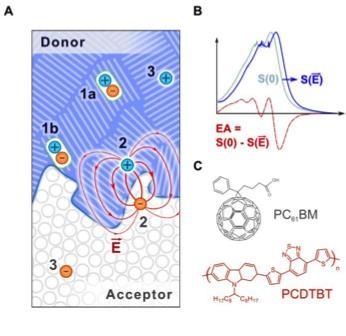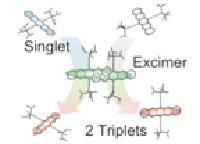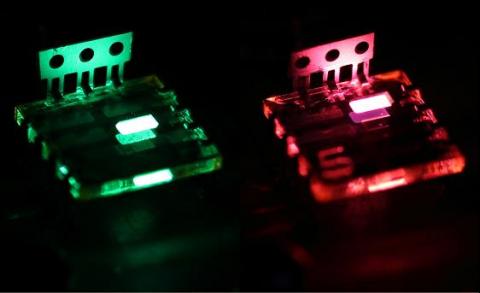 Prof Sir Richard Friend FRS FREng
Prof Sir Richard Friend FRS FREng
For Prof Friend's biography and contact details please see Maxwell Centre Founding Director page.
Current research interests include:
Photogeneration and recombination of charge in molecular semiconductors.
 We and others have developed architectures for molecular semiconductor solar cells can allow high quantum efficiency. We have recently investigated how electrons and holes can separate far enough and fast enough to prevent their mutual electrostatic attraction causing them to recombine We have developed new time resolved laser spectroscopy techniques in my group and these have allowed a real breakthrough in understanding [1,2]. We find that in those materials systems that allow efficient charge separation there is very rapid (< 40 fsec) quantum coherent electron motion across many (>10) molecular units. This is a new paradigm for molecular semiconductor science, relevant also for processes in photosynthesis. Electron spin plays an important role in the process of electron-hole recombination in both photovoltaic diodes, PVs, and light-emitting diodes, LEDs. We investigate the formation of spin-triplet excitons, finding that they can limit both PVs and LEDs but that formation can be controlled by kinetics rather than thermodynamics, allowing improved solar cell performance [3].
We and others have developed architectures for molecular semiconductor solar cells can allow high quantum efficiency. We have recently investigated how electrons and holes can separate far enough and fast enough to prevent their mutual electrostatic attraction causing them to recombine We have developed new time resolved laser spectroscopy techniques in my group and these have allowed a real breakthrough in understanding [1,2]. We find that in those materials systems that allow efficient charge separation there is very rapid (< 40 fsec) quantum coherent electron motion across many (>10) molecular units. This is a new paradigm for molecular semiconductor science, relevant also for processes in photosynthesis. Electron spin plays an important role in the process of electron-hole recombination in both photovoltaic diodes, PVs, and light-emitting diodes, LEDs. We investigate the formation of spin-triplet excitons, finding that they can limit both PVs and LEDs but that formation can be controlled by kinetics rather than thermodynamics, allowing improved solar cell performance [3].
We are just starting an ERC-funded project, EXMOLS, in which we will develop a new platform to study and control electronic excitations in extended molecular systems using DNA assembly methods to construct functional molecular semiconductor stacks. DNA- assembly takes the place here of the protein structure assembly of chromophores within photosynthetic systems. In contrast to current synthetic molecular systems that have little control beyond simple heterojunctions, these DNA-assembled structures will allow for the precise placement of molecules within stack-structures of dimension 5 nm or more, which will allow for the definition of precise electronic couplings and energetic landscapes, within extended artificial molecular systems. New transient optical spectroscopy will track wavefunction evolution from 10fs. These will allow for the study of a range of emergent electronic phenomena on the 5-100nm length scale including, charge delocalisation, coherent electron-hole separation, singlet exciton fission, resonant energy transfer across the organic-inorganic interface and topologically protected electronic excitations.
[1] "Ultrafast Long-Range Charge Separation in Organic Semiconductor Photovoltaic Diodes", S. Gélinas, A. Rao, A. Kumar, S. L. Smith, A. W. Chin, J. Clark, T. S. van der Poll, G. C. Bazan, and R. H. Friend, Science 343, 512-516 (2014). DOI: 10.1126/science.1246249
[2] "The Role of Driving Energy and Delocalized States for Charge Separation in Organic Semiconductors", A. A. Bakulin, A. Rao, V. G. Pavelyev, P. H. M. van Loosdrecht, M. S. Pshenichnikov, D. Niedzialek, J. Cornil, D. Beljonne, and R. H. Friend, Science 335, 1340-1344 (2012). DOI: 10.1126/science.1217745
[3] "The role of spin in the kinetic control of recombination in organic photovoltaics", A. Rao, P. C. Y. Chow, S. Gelinas, C. W. Schlenker, C.-Z. Li, H.-L. Yip, A. K. Y. Jen, D. S. Ginger, and R. H. Friend, Nature 500, 435-439 (2013). DOI 10.1038/nature12339
[4] "Spin-dependent recombination probed through the dielectric polarizability", S. L. Bayliss, N. C. Greenham, R. H. Friend, H. Bouchiat, and A. D. Chepelianskii, Nat Commun 6 (2015). DOI 10.1038/ncomms9534
Singlet exciton fission to triplet exciton pairs and fusion of triplet exciton pairs to singlet excitons.
 The excited state energy spectrum for some molecular semiconductors (particularly pentacene and tetracene) gives a photogenerated spin singlet excited state (or, exciton) with sufficient energy to split into a pair of spin triplet excitons. I started a programme of work on this phenomenon in 2009, showing that the process can be extremely fast (< 100 fsec) and thus very efficient. In the past three years we have explored regimes for the operation of the fission process [1-3] and shown that the triplet excitons generated from this process can be converted to electron-hole pairs at a suitable heterojunction [4] or transferred to a luminescent nanocrystalline inorganic semiconductor [3]. This recent work establishes the process of singlet exciton fission as a very promising route to raise single-junction solar cell efficiencies above the 33% set by the Shockley-Queisser limit. In particular, it may provide a means to increase the efficiency of standard silicon solar cell, by converting photons above 2.2 eV (in the visible part of the spectrum) to pairs of excitations at the silicon bandgap at 1.1 eV.
The excited state energy spectrum for some molecular semiconductors (particularly pentacene and tetracene) gives a photogenerated spin singlet excited state (or, exciton) with sufficient energy to split into a pair of spin triplet excitons. I started a programme of work on this phenomenon in 2009, showing that the process can be extremely fast (< 100 fsec) and thus very efficient. In the past three years we have explored regimes for the operation of the fission process [1-3] and shown that the triplet excitons generated from this process can be converted to electron-hole pairs at a suitable heterojunction [4] or transferred to a luminescent nanocrystalline inorganic semiconductor [3]. This recent work establishes the process of singlet exciton fission as a very promising route to raise single-junction solar cell efficiencies above the 33% set by the Shockley-Queisser limit. In particular, it may provide a means to increase the efficiency of standard silicon solar cell, by converting photons above 2.2 eV (in the visible part of the spectrum) to pairs of excitations at the silicon bandgap at 1.1 eV.
[1] "Identification of a triplet pair intermediate in singlet exciton fission in solution", H. L. Stern, A. J. Musser, S. Gelinas, P. Parkinson, L. M. Herz, M. J. Bruzek, J. Anthony, R. H. Friend, and B. J. Walker, Proceedings of the National Academy of Sciences 112, 7656-7661 (2015). DOI 10.1073/pnas.1503471112
[2] "A transferable model for singlet-fission kinetics", S. R. Yost, J. Lee, M. Wilson, W. B., T. Wu, D. P. McMahon, R. R. Parkhurst, N. J. Thompson, D. N. Congreve, A. Rao, K. Johnson, M. Y. Sfeir, M. Bawendi, T. M. Swager, R. H. Friend, M. A. Baldo, and T. Van Voorhis, Nature Chemistry 6, 492-497 (2014). DOI 10.1038/nchem.1945
[3] "Singlet exciton fission in solution", B. J. Walker, A. J. Musser, D. Beljonne, and R. H. Friend, Nature Chemistry 5, 1019-1024 (2013). DOI 10.1038/nchem.1801
[4] "In situ measurement of exciton energy in hybrid singlet-fission solar cells", B. Ehrler, B. J. Walker, M. L. Böhm, M. W. B. Wilson, Y. Vaynzof, R. H. Friend, and N. C. Greenham, Nature Communications 3, 1019 (2012). DOI 10.1038/ncomms2012
[5] "Resonant Energy Transfer of Triplet Excitons from Organic to Inorganic Semiconductors", M. Tabachnyk, B. Ehrler, S. Gélinas, M. L. Böhm, B. J. Walker, K. P. Musselman, N. C. Greenham, R. H. Friend, and A. Rao, Nature Materials 13, 1033-1038 (2014). DOI 10.1038/NMAT4093
LEDs and lasers based on lead halide perovskites.
 Lead halide perovskited have recently been found to provide unexpectedly efficient thin-film solar cells. We have looked instead at their light-emitting properties, working with Henry Snaith (Oxford), who has pioneered the solar cell developments. We find that these materials show remarkably efficient luminescence and have been able to make efficient LEDs (green, red and IR at present) and optically-pumped lasers.
Lead halide perovskited have recently been found to provide unexpectedly efficient thin-film solar cells. We have looked instead at their light-emitting properties, working with Henry Snaith (Oxford), who has pioneered the solar cell developments. We find that these materials show remarkably efficient luminescence and have been able to make efficient LEDs (green, red and IR at present) and optically-pumped lasers.
[1] "High Photoluminescence Efficiency and Optically-Pumped Lasing in Solution-Processed Mixed Halide Perovskite Semiconductors", F. Deschler, M. Price, S. Pathak, L. Klintberg, D. D. Jarausch, R. Higler, S. Huettner, T. Leijtens, S. D. Stranks, H. J. Snaith, M. Atature, R. T. Phillips, and R. H. Friend, The Journal of Physical Chemistry Letters 5, 1421-1426 (2014). DOI 10.1021/jz5005285
[2] "Bright light-emitting diodes based on organometal halide perovskite", Z.-K. Tan, R. S. Moghaddam, M. L. Lai, P. Docampo, R. Higler, F. Deschler, M. Price, A. Sadhanala, L. M. Pazos, D. Credgington, F. Hanusch, T. Bein, H. J. Snaith, and R. H. Friend, Nature Nanotechnology 9, 687-692 (2014). DOI 10.1038/nnano.2014.149
[3] "Hot-carrier cooling and photoinduced refractive index changes in organic-inorganic lead halide perovskites", M. B. Price, J. Butkus, T. C. Jellicoe, A. Sadhanala, A. Briane, J. E. Halpert, K. Broch, J. M. Hodgkiss, R. H. Friend, and F. Deschler, Nature Communications 6, 8420-8420 (2015). DOI 10.1038/ncomms9420
